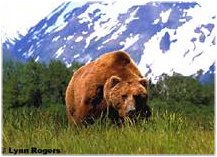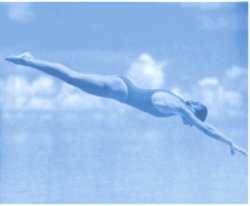
Who is "Fat" and "Hairless" and Who is Not?
| There are two major groups of animals that do have high fat to body size ratios: Hibernators (including estuators), and aquatic mammals. It is clear that we are not hibernators, or estuators. Adding in the reduction of body hair leaves only the aquatic and semi-aquatic mammals, other than humans, that demonstrate these higher fat ratios combined with a layer of fat (Morgan 1997). | 
|
 Photo courtesy Elaine Morgan |
The aquatic hypotheses proposes that our loss of hair and development of our fatty layer is a
natural response to moving into a semi-aquatic ecological niche (Morgan and Verhaegen).
Most medium to large sized aquatic mammals have gone this route.
This is seen readily when looking at dolphins, whales, walruses, manatees and even ex-aquatics
like pigs, rhinos, and hippos (although the hippo is still a semi-aquatic mammal). This does a few things: Increased fat allows for better buoyancy, and thermal regulation in water (P.F. Scholander et al.1950). Loss of "fur" allows for a more stream-lined body, and ease of movement through the water. |
When an animal leaves the land, and imparts on the journey back to the sea, as so many have already done, it must adapt. All animals, like the predecessor of the beaver and that of the dolphin would have been forced to acquire one or both of two things:
Oily, you say?
Not only do we have a layer of fat adhereing to our skin and happily secreting oil glands, but we seem to have lost a layer of
cutaneous muscle! This layer the "panniculus carnosus", is typically found in most
all terrestrial mammals, including all primates, and allows for "twitching" of the skin. This could be due to the
acquistion of the fatty layer perhaps making the skin "too thick" to "twitch" (Morgan 1997).
We have only a small patch on the
neck left, and hence we cannot "twitch" away insects the way other animals do. Though, some people
can "twitch" their ears!
Okay, so what about those larger aquatic mammals which do have fur?
Okay, so what about the hair on our head...and elsewhere?
The majority of heat loss is through the top of one's head, (remember your mum saying "put that
hat on !"). Hair would have naturally remained on the head, to prevent heat loss, and sunstroke.
It has also been suggested that the long hair length on the head may have given babies something to
hold onto. Women's hair does grow quicker and thicker during pregnancy, and this is not well
researched, or explained currently. Hair length may also have been a sexually selected trait, like
the bright feathers of a bird. As for hair on the pubic region and armits, it may have something to do
with distributing pheromones, or help with reducing friction created by wet skin.

It is argued that if mankind's ancestors did take an aquatic route in their evolution then why
did we not retain our fur and get fat, like a seal, or a sea lion. The answer to this is quite
simple: seals and sea lions evolved in much cooler climbs, and still need to leave the sea to
breed. There, the thick layer of blubber in combination with the fur would have been
advantageous for them to retain. Man's ancestors evolved in a warm environment, thus this
environmental stress was non-existent (Morgan 1982). We have retained our hair, only it is greatly
reduced in size overall.